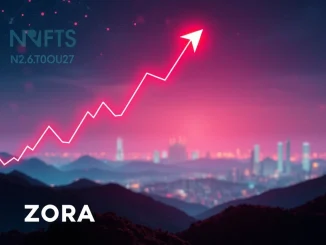
Exciting news is circulating in the world of **DeFi**! Researchers at Paradigm, a well-regarded crypto investment firm known for its deep dive into blockchain technology, have unveiled a fascinating new concept. They’re calling it **Paradigm Orbitals**. This isn’t just another incremental update; it’s a proposal for a fundamentally new type of Automated Market Maker (AMM) designed with a very specific, and increasingly important, challenge in mind: managing massive pools of stablecoins efficiently.
What is a **Stablecoin AMM** and Why Do We Need a New One?
Before diving into Orbitals, let’s quickly recap. An AMM is the backbone of many decentralized exchanges (DEXs). Instead of traditional buy and sell orders, AMMs use liquidity pools of two or more assets and mathematical formulas to determine prices. Users trade against this pool, and liquidity providers earn fees.
Stablecoins are cryptocurrencies designed to maintain a stable value, usually pegged to a fiat currency like the US dollar. They are crucial for trading, lending, and borrowing in DeFi because they reduce volatility.
Trading between different stablecoins (like USDC, USDT, DAI) is incredibly common. However, traditional AMMs, especially those designed for volatile pairs (like ETH/DAI), aren’t always the most efficient for stablecoin-to-stablecoin swaps. Why?
- Stablecoins are supposed to trade near 1:1. Standard AMM curves often result in unnecessary price slippage even for small trades, because the curve is designed for pairs whose prices move significantly relative to each other.
- To minimize this slippage, existing stablecoin AMMs often require vast amounts of capital locked in pools, which isn’t the most capital-efficient use of funds.
Existing solutions like Curve Finance’s StableSwap have addressed this with specific curves optimized for assets that should trade near parity. However, as the number and volume of stablecoins grow, managing liquidity efficiently across potentially dozens or even hundreds of stablecoins in a single pool becomes exponentially complex.
Enter **Paradigm Orbitals**: Revolutionizing **Concentrated Liquidity**
The core idea behind Orbitals, as proposed by Paradigm researchers, is to extend the concept of concentrated liquidity into higher dimensions. You might be familiar with concentrated liquidity from platforms like Uniswap V3.
In traditional AMMs, liquidity is spread evenly across the entire possible price range (from zero to infinity). This means a lot of the capital isn’t actively used unless the price is within a very specific, often narrow, range where most trading occurs.
Concentrated liquidity allows liquidity providers (LPs) to allocate their capital to specific, narrow price ranges where they expect trading to happen. This makes the capital significantly more efficient within that range, potentially leading to lower slippage for traders and higher fee yields for LPs.
Orbitals takes this idea and applies it to pools with *many* assets, not just two. Imagine a pool with three stablecoins (A, B, C). Instead of thinking about a single price range (like A vs B), you’re dealing with a price *space* (A vs B, A vs C, B vs C, and combinations). As you add more assets, this space becomes ‘higher-dimensional’.
Orbitals proposes a way to define and manage concentrated liquidity within this complex, multi-asset space. The proposal outlines a hypothetical **AMM** structure capable of handling pools ranging from a simple 2-asset pair all the way up to potentially 10,000 assets or more, all while aiming for capital efficiency.
Key Benefits and What This Means for **DeFi**
If successfully implemented, a concept like Orbitals could bring several significant advantages:
- **Improved Capital Efficiency:** By concentrating liquidity where it’s most needed across multiple assets, less total capital could be required to achieve the same level of low slippage compared to existing methods for large stablecoin pools.
- **Reduced Slippage for Large Swaps:** More efficient use of capital should directly translate into better execution prices for traders, especially for larger swaps between different stablecoins.
- **Support for Massive Pools:** The ability to efficiently manage pools with a very high number of assets opens the door for aggregating liquidity across a vast array of stablecoins, potentially including fiat-pegged, commodity-pegged, or even algorithmic stablecoins.
- **New Possibilities for LPs:** Liquidity providers might gain more granular control over where their capital is deployed within these multi-asset pools, potentially optimizing their yield strategies.
This research by Paradigm highlights the ongoing innovation in the DeFi space, constantly pushing the boundaries of how decentralized finance protocols can operate more efficiently and at scale. While Orbitals is currently a theoretical proposal, it lays the groundwork for future AMM designs that could handle the increasing complexity and volume of stablecoin interactions.
Challenges on the Horizon
Developing and deploying such a sophisticated system is not without its hurdles:
- **Complexity:** Managing concentrated liquidity in higher dimensions is mathematically and computationally complex. Implementing this securely and efficiently on a blockchain is a significant technical challenge.
- **Gas Costs:** Interacting with such a complex smart contract could potentially incur high transaction fees, depending on the underlying blockchain and implementation details.
- **LP Strategy:** For liquidity providers, understanding and optimizing their positions in a multi-dimensional concentrated liquidity pool would be significantly more complex than in current AMMs.
- **Auditing and Security:** The novelty and complexity would require extensive auditing and testing to ensure security and prevent exploits.
The Future of **AMM** Design?
The **Paradigm Orbitals** proposal represents a bold step forward in AMM research. It directly addresses the growing need for more efficient ways to handle large and diverse pools of stable assets within DeFi. While it remains a theoretical concept for now, the ideas presented could influence the next generation of decentralized exchange protocols, making stablecoin trading more efficient and unlocking new possibilities for liquidity provision.
This focus on improving core DeFi infrastructure is crucial for the ecosystem’s continued growth and adoption. As more assets become tokenized and stablecoin usage expands globally, efficient, scalable, and capital-efficient trading mechanisms will be paramount. Paradigm’s work here contributes significantly to that ongoing effort.
In Summary
Paradigm’s Orbitals proposal introduces a novel approach to building Automated Market Makers capable of managing large, multi-asset stablecoin pools with enhanced capital efficiency. By extending concentrated liquidity into higher-dimensional spaces, it aims to reduce slippage and improve resource utilization compared to existing AMM designs. While complex challenges remain, this research is a promising development for the future of DeFi infrastructure and stablecoin trading.



